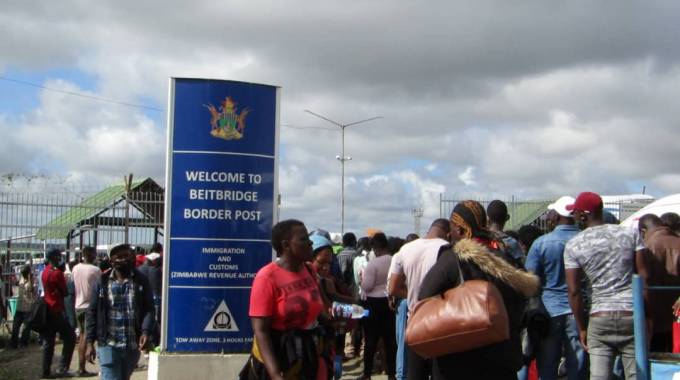How gold is smuggled from Zimbabwe

A report by the International Crisis Group last year estimated that cash-strapped Zimbabwe is losing at least US$1.5 billion annually through the smuggling of gold, mainly to traders in Dubai and South Africa.
By Dumisani Nyoni
The figure is, however, higher than the government’s estimates of US$1.2 billion a year lost through the illicit gold trade.
Zimbabwe boasts vast gold reserves, and the sector accounts for 60% of Zimbabwean exports.
Roughly 40 000 small-scale miners are registered in Zimbabwe, employing on average at least 10 workers each, according to the Zimbabwe Miners Federation (ZMF).
However, gold smuggling to other countries, particularly South Africa and the United Arab Emirates, is choking the sector.
For instance, just recently, a 33-year-old Zimbabwean man was arrested at O.R. Tambo International Airport in Johannesburg on May 8 with smuggled gold worth R11 million (about US$730,000).
Tashinga Masinire flew into one of Africa’s busiest airports with 23 pieces of gold which he did not declare, and when challenged “he did not have any permit or licence to be in possession to transport gold.”
But how is this precious metal leaving the country?
A new report titled: Illicit gold markets in east and southern Africa by the Global Initiative Against Transnational Organized Crime (Global Initiative) has tried to answer this question.

The report notes that smugglers are hiding smaller quantities of gold in clothing and headdresses, while larger amounts are stowed away in car glove compartments, spare wheels and any other parts of a vehicle that can be modified for smuggling purposes.
“Similarly, in Southern Africa, gold is easily smuggled from Zimbabwe into South Africa. Porous land borders make it easy for criminal groups to cross into South Africa where laundering opportunities and transport services are more readily available,” the report reads in part.
“While there are informal border crossings, the official Beitbridge border post remains a preferred route for gold smugglers. Smaller quantities of gold are hidden in clothing and headdresses, while larger amounts are stowed away in car glove compartments, spare wheels and any other parts of a vehicle that can be modified for smuggling purposes.”
In both east and southern Africa, Global Initiative said trucking is a popular way to smuggle large gold shipments.
On the Zimbabwe-South Africa border, both bus drivers and truckers are reported to smuggle gold.
On the Democratic Republic of Congo (DRC)–Uganda border, gold is hidden in trucks that can bypass COVID-19 restrictions to deliver ‘essential goods’. Bars weighing between five and 20 kilograms are stuffed underneath truck cabins, inside battery compartments and emptied gasoline tankers.
“As a result, some major buyers have invested in both gold and trucking. For example, certain major gold dealers in Harare have invested in the gas business, enabling the use of gas haulage trucks with secret compartments to smuggle gold into South Africa,” it said.
On the borders, there appears to be a lack of capacity and will to stop gold smuggling.
For example, in Zimbabwe, only luggage is subject to scans by customs officials so travellers without luggage are unlikely to be searched, the report says.
The report also reveals that larger smuggling operations will also involve collusion between criminal actors and border officials.
“In Southern Africa, Johannesburg is the regional gold magnet, although there are reports that significant and increasing amounts of gold are being exported directly from Harare to Dubai and other international destinations,” it said.
“In Johannesburg, locally produced gold and imports from neighbouring countries, especially Zimbabwe, is traded and laundered. Some is laundered into formal supply chains through local refineries.”
Similarly, Global Initiative says in Zimbabwe smuggling gold out of Harare’s airport is suspected of being done by powerful gold dealers and political elites.
It was reported that individuals moving gold as jewellery will make at least one to two trips each month, the report says.
The report notes that gold mined in Zimbabwe is moved to the trading hubs of Harare and Bulawayo before it is smuggled or exported out of the country. While Bulawayo’s reach is limited to gold mined in areas close to the town, Harare attracts gold from across the country.
Bulawayo buyers are generally less well-resourced and lack the US dollar buying power of their Harare competitors, it said.
Miners or buyers may also take gold directly to South Africa, especially from Matabeleland province in the south. Nearly 40% of gold mined in Matabeleland is believed to be smuggled directly to South Africa, it said.
In 2015, the Reserve Bank of Zimbabwe (RBZ) reported that the border was contributing to “… the most [gold] leakages that the country has ever experienced.”
The ease in which gold can be moved over the border makes it difficult to catch smugglers, Global Initiative says.
“It is reported that a smuggler will only be caught if the police have received a tip-off but they can easily pay a bribe to allow them to continue across the border.”
In other instances, the report revealed that gold is moved to South Africa through Botswana to avoid the heavily congested Beitbridge crossing.
South Africa’s strict lockdowns in response to COVID-19 have forced smugglers from Zimbabwe to increase their use of the Botswana route to come into South Africa.
A significant and growing amount of gold is also believed to be flown out of Harare airport to international transit and destination hubs, particularly the UAE, China and India and, to a lesser extent, Russia.
This route is suspected to be used by more powerful gold dealers and political elites.
“Indian buyers are allegedly the most likely to smuggle gold in this manner. There are also small gold flows between Zimbabwe and Mozambique in border regions, but the direction of the flows is unclear,” the report says.
Smuggling is rife
Gold buyers interviewed by the Global Initiative revealed that they were selling between 10% and 30% of their gold to the Fidelity Printers and Refiners (FPR) only to maintain their gold licences, with the rest being sold on the illicit market.
Major foreign buyers, often from South Africa, partner with Zimbabwean dealers to buy large quantities of gold on the illicit market, the report says.
Recommendations
As part of the recommendations to curb smuggling, the report suggests that criminal investigations should target the activities of key actors in the illicit gold trade, including senior government officials.
“This could include increased support for financial intelligence units and financial investigations. By providing information and support, foreign governments and international law enforcement bodies can support efforts to identify and prosecute key individuals, companies and financial institutions linked to or involved in the illicit gold trade,” it said.
“This can lead to improved reporting on suspicious transactions and knowledge of laundering methods and flows.”
It also said law enforcement, including customs officials, can also target enforcement activity at major transit points.
Because international airports are key bottleneck points in supply chains, effective policing there will have a significant impact on illicit gold flows, it said.
“In addition, smugglers tend to favour major border crossings when moving large amounts of gold. Targeting key road border crossings may therefore also reduce the ease with which gold is smuggled out of source countries.”
“Private sector actors, in particular refinery and smelter-level programmes, should strive to responsibly source gold from source countries, as opposed to refusing to source product from high-risk areas or disengaging from artisanal and small-scale gold mining (ASGM) entirely,” the report says.
Global Initiative said sourcing gold directly from source countries has the benefit of improving downstream knowledge of supply chains as well as establishing responsible sourcing practices, thereby also supporting the sustainable development of the sector.
It said increasing the number of ASGM sourcing options will help to grow and regularize responsible ASGM gold supply.
“This will require developing flexible and tailored solutions on the ground. This can include securing individual supply chains and increased acceptance of sourcing gold from mines that are in the process of achieving certification or meeting due diligence requirements,” it recommended.
“The transnational nature of illicit gold markets requires cooperation between law enforcement, customs services and other relevant bodies to combat criminality. In both source and destination countries, competent authorities need to be adequately staffed, funded and trained. Communication strategies between government bodies at the national level are also needed to close coordination gaps.”
Global Initiative also recommended that enforcement should also focus on transit and trade hubs, particularly the strengthening of enforcement controls at airports.
“Land borders are difficult to police, while the geographically remote and dispersed nature of ASGM makes it a challenge to regulate mine sites. This means enforcement efforts must look further downstream to transit and trade hubs for solutions.”
“This could include assistance to airlines to better enable them to detect smuggled gold, possibly in partnership with international trade organizations,” it said.
The Centre for Natural Resource Governance says poor gold prices offered by FPR were fueling smuggling. Hence, to curb smuggling, the issue of gold prices should be addressed.
The poor price is the result of FPR using a mix of United States dollars and Zimbabwean dollars to pay for precious metals.
This article first appeared in the Mining Zimbabwe Magazine June 2021 issue


